


Malachite

FOSSICKING IN SOUTH WEST VICTORIA
South west Victoria is predominately a farming area. Warrnambool, the regional centre, is located on the
coast and has a population of some 30,000 people.
Fossicking sites are limited in the region as most land is privately owned and generally inaccessible to
fossickers. Currently (2016) club members fossick at the quarry at Mt Shadwell in Mortlake. Two other
localities near Warrnambool which we previously accessed are also described below.
These locations are:
1. The Mount Shadwell quarry (operated by the Moyne shire) which is located
at Mortlake, some 45km inland (north) of Warrnambool. The quarry produces road making materials
(different grades of scoria). In the quarry volcanic "bombs" can be found, some of which contain gem
peridot.
If you are visiting Mt Shadwell for fossicking, be aware that it is only possible to
fossick on Friday, Saturday and Sundays.Bookings are essential, to book please
contact the Moyne Shire Information centre (03) 5599 2899 between 10am and 4pm
Monday to Thursday or 0456 700 862 between 10am and 4pm Friday to
Sunday.Visitors are required to follow an induction session and sign an indemnity
form.!
Over recent years club members have been finding increasing amounts of orange/golden/yellow peridot
as well as the "normal" green peridot. Many variations in between these two extreme colours have also
been found. Typically the rich green peridot has been found in the black scoria in the quarry whereas the
"golden peridot" has been located in the red scoria. However this is not always the case, as single bombs
can be found containing both yellow and green peridot as well as many other colours in between these
two extremes.
Peridot is the name generally given by lapidary enthusiasts to gem quality olivine. Olivine is a
"magnesium iron silicate" which follows the formulae (Mg,Fe)2SiO4. This mineral is one of an
isomorphous series which varies from the magnesium silicate "forsterite" (Mg2SiO4) to the iron silicate
"faylite" (Fe2SiO4). this variation in the amounts of iron and magnesium influences the different colours in
the peridot found at Mortlake. Several of our club members have good collections of faceted peridot
which show the variation in colours present in the material that can be fossicked from Mt Shadwell. The
photos show some faceted gems cut by Brian Alexander and Alan Wood, (Warrnambool Gem Club
members), a ‘volcanic bomb’ and a view of the
quarry. The gems range up to 4.6ct in weight and
provide a good indication of the wide range of
colours available. The larger gems often contain
small inclusions but still cut very attractive
gemstones.
Fossicking for Peridot at Mt Shadwell
Mt Shadwell is well known locally for its volcanic bombs,
which range in size from a few centimetres across to huge
specimens over a metre long; although the majority of
bombs would measure around 10 to 15cm in diameter. Most
of the bombs have spectacular olivine cores with a thin
coating of scoria on the outside. Unfortunately, the olivine
core usually consists of small crystals the size of grains of
sugar. The bombs which we gem hunters seek are those which contain peridot of a size suitable for faceting. You generally
have to break open many of the "sugary bombs" before you strike a "gemmy" bomb with suitable material within it. If you are
lucky you may also find an occasional bomb yielding anorthoclase of a size suitable for faceting a nice gem.
Mt Shadwell is the type of place you can visit and find "plenty" or "nothing" if you are looking for facetable peridot. I have
visited the quarry on several occasions when I found no facetable material, while at the same time some of my companions
were finding nice bombs with gem material within. However, my last 7 visits have yielded several bombs containing good
gem material each time. Each "good bomb" can yield several "cutters". So like many fossicking locations, you have to be
digging in the "right spot" at the "right time"!
During the last 12 months our club has hosted visits by several clubs, both Victorian and interstate.
If you plan to visit Mt Shadwell quarry, you should first visit the Moyne Shire offices at 1 Jamieson Ave., in Mortlake to
sign a consent form. The staff at the shire offices are very helpful and can put you in contact with Alan Wood, a
Warrnambool Gem club member who lives in Mortlake (except when he migrates north during winter, on fossicking trips)
and who is usually only to happy to help visiting fossickers.
Alan has become the local "expert" on the minerals to be found at Mt Shadwell. He has an excellent collection of "gemmy
bombs" from the Mount and a good display of peridot gems which he has faceted from such bombs. While locals take these
"bombs" for granted, there are very few places in the world where such volcanic bombs can be found. Calcite "micromount"
specimens can also be collected at Mt Shadwell with little difficulty.
While you are at the quarry, a good place to look for the peridot is in the large stockpile of "volcanic bombs" that the
quarry operators (the Moyne shire) stockpile for fossickers to work through. Many good pieces of peridot have been
obtained from that stockpile!
When visiting the quarry you should wear a high visibility vest and follow the directions of the quarry foreman. The main
equipment you need is a good geo pick/hammer and something to carry your finds in. Good footwear and long trousers are
also essential.
Notes:
1. Isomorphism: is the phenomenon where the atoms of one element (such as Fe, iron) replace the atoms of another
element (such as Mg, magnesium) in the crystal lattice to produce a continuum of minerals between the two extremes.
Some cut gems by
A.Wood, Mortlake
olivine. 2018
One of the better
volcanic bombs
Alan has found!
Many gems were
cut from the other half
of this bomb.
Two faceted gems from
Mt Shadwell, L.H. gem
18 mm long.
2. Lake Keilambete (‘Fentons quarry’, privately owned) which produces limestone for soil conditioning
purposes and for road material. A variety of fossils including sharks teeth can be found at this quarry. PLEASE NOTE THAT
THE CLUB HAS BEEN UNABLE TO CONTACT THE QUARRY OWNERS SINCE 2013 AND SO HAVE NOT BEEN ABLE
TO ACCESS THE QUARRY.
Lake Keilambete near Terang is a half hour drive east of Warrnambool. Here fossickers can search for marine fossils in
Ian Fenton’s limestone quarry on the edge of the lake. Lake Keilambete is a maar volcano, approximately 50,000 years old,
located some 4km northwest of Terang. There are many such maar volcanos in the western district. They result from
explosions occurring when hot magma rises into rocks which are not far from the surface and which contain lots of ground
water. High pressure steam is produced, which blasts the magma and surrounding rocks into clouds of small fragments.
Lake Keilambete’s circular crater, which resulted from such an
eruption/explosion, is quite beautiful. It is some 2.4km in diameter and
40m deep, with the lake up to 9m deep. (Ref. 1) The crater is
surrounded by a tuff ring with limestone below the tuff. It is this limestone
and tuff that is mined in the quarry and it is in the limestone that the
fossils can be found.
Ian Fenton had been operating the quarry since the late 1960’s for
material to make farm tracks with the limestone also being used for ‘soil
conditioning’. Over that time Ian collected a good set of fossils. Of particular note is his very impressive collection of fossil
sharks teeth, one of which is shown below. Ian has since sold the quarry.
During field trips a number of impressive fossils have been collected. At the quarry a variety of 40 - 50 million year old
fossils can be found, ranging from whale vertebrate and the sharks teeth to many different types of shells. Fossickers
wishing to visit the quarry would need to contact/locate the ‘current’ owners prior to visiting the area. The photos show the
quarry next to the lake plus a fossil shark’s tooth.
‘Tarrone’ quarry is located a half hours drive north-west of Warrnambool. This quarry, which is not open
to the general public, is a working quarry and is inaccessible during the week when excavation and blasting work is
undertaken. It is necessary to obtain special permission if you wish to fossick there, and members of the Warrnambool were
only able to obtain access the quarry because a club member worked at the site. The club has not accessed the site for
several years. The field trips to Tarrone enable the collection of zeolite specimens; club members having found a number of
beautiful aragonite and calcite specimens in recent visits. The fossicking involves the use of hammers and rock chisels in
the breaking open of basalt boulders in the search for minerals/crystals. Typical finds include calcite crystals plus aragonite
and augite specimens, some of which are shown in the photos below.
References:
1. Volcanoes in Victoria, Royal Society of Victoria, W.Birch, 2000

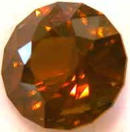
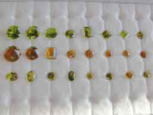
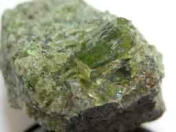
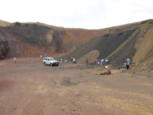


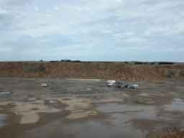
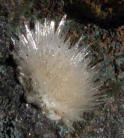
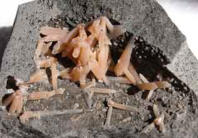
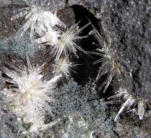
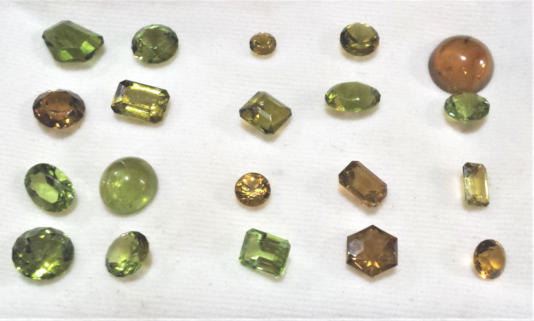
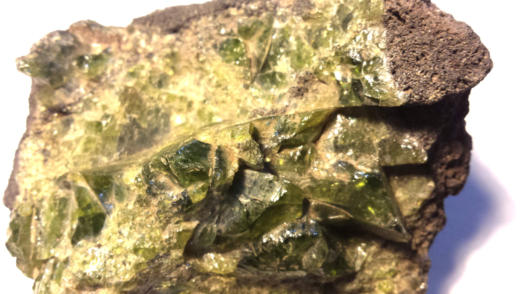
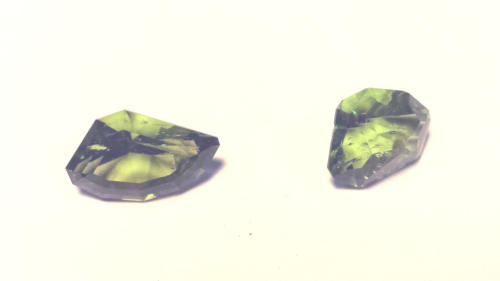


- index
- contact-us
- club activities 2021 -
- Club activities 2021 --a
- Club activities 2021 --b
- club activities 2019_20
- club activities 2017_18
- club activities 2016
- club activities 2015_2014
- club activities 2013_2012_2011
- club activities 2010_2009_2008
- club activities 2007_2006_2005_2004
- club shows 2004_2016
- club shows 2018 _
- office bearers and life members
- club history
- links
- fossicking in south west victoria
- places you might like to visit
- europe 2014
- usa_canada_gems_geology
- Canada_hawaii_gems_geology
- gem_mineral collections
- some australian gems
- Gem articles
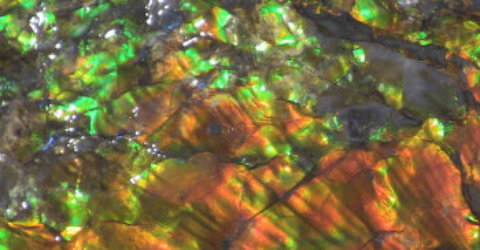


Elbaite crystals

FOSSICKING IN SOUTH
WEST VICTORIA
South west Victoria is predominately a farming area. Warrnambool, the
regional centre, is located on the coast and has a population of some
30,000 people.
Fossicking sites are limited in the region as most land is privately owned
and generally inaccessible to fossickers. Currently (2016) club members
fossick at the quarry at Mt Shadwell in Mortlake. Two other localities
near Warrnambool which we previously accessed are also described
below.
These locations are:
1. The Mount Shadwell quarry (operated by
the Moyne shire) which is located at Mortlake, some 45km inland (north)
of Warrnambool. The quarry produces road making materials (different
grades of scoria). In the quarry volcanic "bombs" can be found, some of
which contain gem peridot.
If you are visiting Mt Shadwell for fossicking, be aware
that it is only possible to fossick on Friday, Saturday and
Sundays.Bookings are essential, to book please contact
the Moyne Shire Information centre (03) 5599 2899
between 10am and 4pm Monday to Thursday or 0456 700
862 between 10am and 4pm Friday to Sunday.Visitors are
required to follow an induction session and sign an
indemnity form.!
Over recent years club members have been finding increasing amounts
of orange/golden/yellow peridot as well as the "normal" green peridot.
Many variations in between these two extreme colours have also been
found. Typically the rich green peridot has been found in the black
scoria in the quarry whereas the "golden peridot" has been located in
the red scoria. However this is not always the case, as single bombs
can be found containing both yellow and green peridot as well as many
other colours in between these two extremes.
Peridot is the name generally given by lapidary enthusiasts to gem
quality olivine. Olivine is a "magnesium iron silicate" which follows the
formulae (Mg,Fe)2SiO4. This mineral is one of an isomorphous series
which varies from the magnesium silicate "forsterite" (Mg2SiO4) to the
iron silicate "faylite" (Fe2SiO4). this variation in the amounts of iron and
magnesium influences the different colours in the peridot found at
Mortlake. Several of our club
members have good collections of
faceted peridot which show the
variation in colours present in the
material that can be fossicked
from Mt Shadwell. The photos
show some faceted gems cut by
Brian Alexander and Alan Wood,
(Warrnambool Gem Club
members), a ‘volcanic bomb’ and
a
view of the quarry. The gems
range up to 4.6ct in weight and provide a good indication of the wide
range of colours available. The larger gems often contain small
inclusions but still cut very attractive gemstones.
Fossicking for Peridot at Mt Shadwell
Mt Shadwell is well known locally for its volcanic bombs, which range in size from
a few centimetres across to huge specimens over a metre long; although the
majority of bombs would measure around 10 to 15cm in diameter. Most of the
bombs have spectacular olivine cores with a thin coating of scoria on the outside.
Unfortunately, the olivine core usually consists of small crystals the size of grains of
sugar. The bombs which we gem hunters seek are those which contain peridot of a
size suitable for faceting. You generally have to break open many of the "sugary
bombs" before you strike a "gemmy" bomb with suitable material within it. If you are
lucky you may also find an occasional bomb yielding anorthoclase of a size suitable
for faceting a nice gem.
Mt Shadwell is the type of place you can visit and find "plenty" or "nothing" if you
are looking for facetable peridot. I have visited the quarry on several occasions
when I found no facetable material, while at the same time some of my companions
were finding nice bombs with gem material within. However, my last 7 visits have
yielded several bombs containing good gem material each time. Each "good bomb"
can yield several "cutters". So like many fossicking locations, you have to be digging
in the "right spot" at the "right time"!
During the last 12 months our club has hosted visits by several clubs, both
Victorian and interstate.
If you plan to visit Mt Shadwell quarry, you should first visit the Moyne Shire
offices at 1 Jamieson Ave., in Mortlake to sign a consent form. The staff at the shire
offices are very helpful and can put you in contact with Alan Wood, a Warrnambool
Gem club member who lives in Mortlake (except when he migrates north during
winter, on fossicking trips) and who is usually only to happy to help visiting
fossickers.
Alan has become the local "expert" on the minerals to be found at Mt Shadwell.
He has an excellent collection of "gemmy bombs" from the Mount and a good
display of peridot gems which he has faceted from such bombs. While locals take
these "bombs" for granted, there are very few places in the world where such
volcanic bombs can be found. Calcite "micromount" specimens can also be
collected at Mt Shadwell with little difficulty.
While you are at the quarry, a good place to look for the peridot is in the large
stockpile of "volcanic bombs" that the quarry operators (the Moyne shire) stockpile
for fossickers to work through. Many good pieces of peridot have been obtained
from that stockpile!
When visiting the quarry you should wear a high visibility vest and follow the
directions of the quarry foreman. The main equipment you need is a good geo
pick/hammer and something to carry your finds in. Good footwear and long trousers
are also essential.
Notes:
1. Isomorphism: is the phenomenon where the atoms of one element (such as Fe,
iron) replace the atoms of another element (such as Mg, magnesium) in the crystal
lattice to produce a continuum of minerals between the two extremes.
Above: a selection of gems cut from Mt Shadwell olivine.
2. Lake Keilambete (‘Fentons quarry’, privately owned) which
produces limestone for soil conditioning purposes and for road material. A variety of
fossils including sharks teeth can be found at this quarry. PLEASE NOTE THAT
THE CLUB HAS BEEN UNABLE TO CONTACT THE QUARRY OWNERS SINCE
2013 AND SO HAVE NOT BEEN ABLE TO ACCESS THE QUARRY.
Lake Keilambete near Terang is a half hour drive east of Warrnambool. Here
fossickers can search for marine fossils in Ian Fenton’s limestone quarry on the
edge of the lake. Lake Keilambete is a maar volcano, approximately 50,000 years
old, located some 4km northwest of Terang. There are many such maar volcanos in
the western district. They result from explosions occurring when hot magma rises
into rocks which are not far from the surface and which contain lots of ground water.
High pressure steam is
produced, which blasts the
magma and surrounding rocks
into clouds of small fragments.
Lake Keilambete’s circular
crater, which resulted from such
an eruption/explosion, is quite
beautiful. It is some 2.4km in
diameter and 40m deep, with the lake up to 9m deep. (Ref. 1) The crater is
surrounded by a tuff ring with limestone below the tuff. It is this limestone and tuff
that is mined in the quarry and it is in the limestone that the fossils can be found.
Ian Fenton had been operating the quarry since the late 1960’s for material to
make farm tracks with the limestone also being used for ‘soil conditioning’. Over that
time Ian collected a good set of fossils. Of particular note is his very impressive
collection of fossil sharks teeth, one of which is shown below. Ian has since sold the
quarry.
During field trips a number of impressive fossils have been collected. At the quarry
a variety of 40 - 50 million year old fossils can be found, ranging from whale
vertebrate and the sharks teeth to many different types of shells. Fossickers wishing
to visit the quarry would need to contact/locate the ‘current’ owners prior to visiting
the area. The photos show the quarry next to the lake plus a fossil shark’s tooth.
‘Tarrone’ quarry is located a half hours drive north-west of
Warrnambool. This quarry, which is not open to the general public, is a working
quarry and is inaccessible during the week when excavation and blasting work is
undertaken. It is necessary to obtain special permission if you wish to fossick there,
and members of the Warrnambool were only able to obtain access the quarry
because a club member worked at the site. The club has not accessed the site for
several years. The field trips to Tarrone enable the collection of zeolite specimens;
club members having found a number of beautiful aragonite and calcite specimens
in recent visits. The fossicking involves the use of hammers and rock chisels in the
breaking open of basalt boulders in the search for minerals/crystals. Typical finds
include calcite crystals plus aragonite and augite specimens, some of which are
shown in the photos below.
References:
1. Volcanoes in Victoria, Royal Society of Victoria, W.Birch, 2000







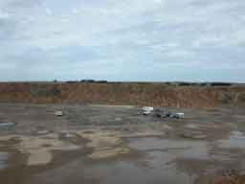
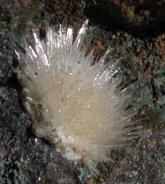
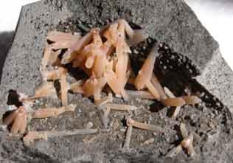
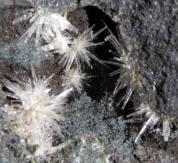
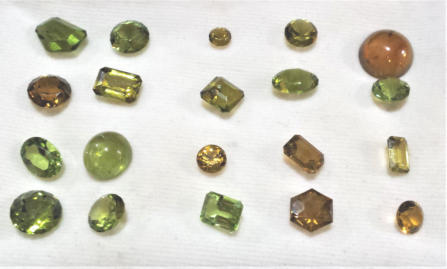


- index
- contact-us
- club activities 2021 -
- Club activities 2021 --a
- Club activities 2021 --b
- club activities 2019_20
- club activities 2017_18
- club activities 2016
- club activities 2015_2014
- club activities 2013_2012_2011
- club activities 2010_2009_2008
- club activities 2007_2006_2005_2004
- club shows 2004_2016
- club shows 2018 _
- office bearers and life members
- club history
- links
- fossicking in south west victoria
- places you might like to visit
- europe 2014
- usa_canada_gems_geology
- Canada_hawaii_gems_geology
- gem_mineral collections
- some australian gems
- Gem articles











